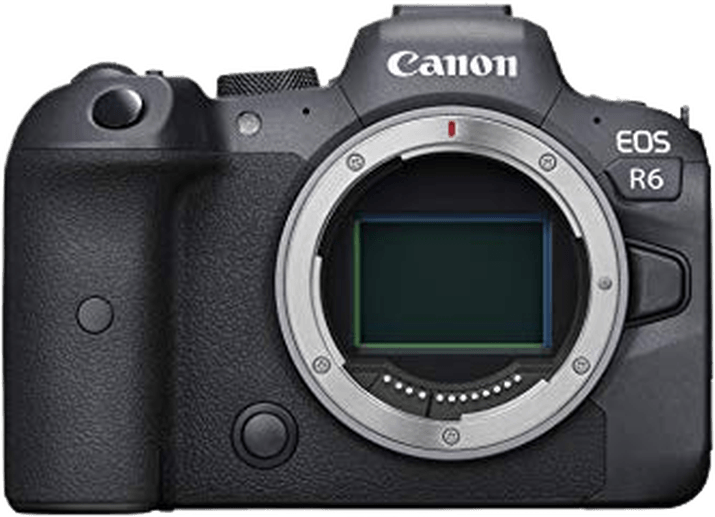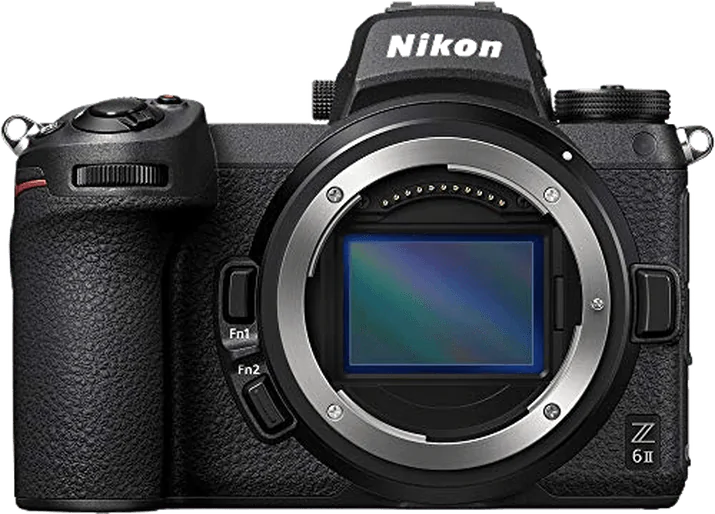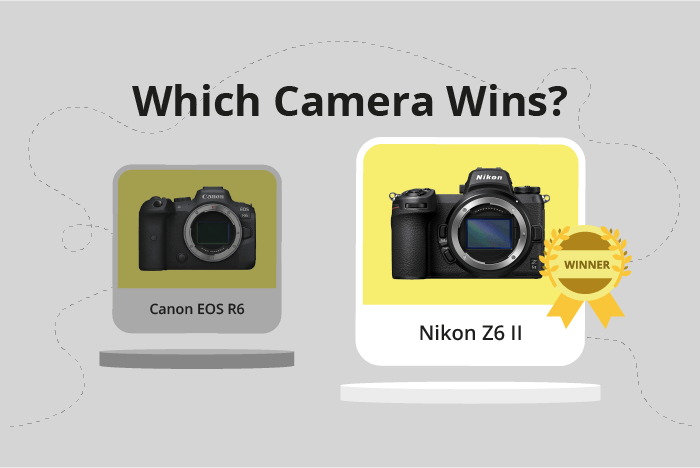Canon EOS R6 vs Nikon Z6 II Comparison
Canon EOS R6

Nikon Z6 II

The Nikon Z6 II takes the lead with a score of 83/100, while the Canon EOS R6 follows closely with 80/100. Both cameras are mirrorless, released in 2020, and share similar dimensions: the Canon EOS R6 measures 138 x 98 x 88mm and weighs 680g, while the Nikon Z6 II measures 134 x 101 x 70mm and weighs 705g.
The Canon EOS R6 has a higher launch price at $2499, but it is slightly lighter than the Nikon Z6 II, making it more comfortable to carry around. On the other hand, the Nikon Z6 II has a lower launch price of $1995, offering better value for money.
Considering the close scores and shared specifications, both cameras have their advantages. The Canon EOS R6’s lighter weight may appeal to photographers who prioritize portability, while the Nikon Z6 II’s lower price makes it a more affordable option. Ultimately, the choice depends on individual preferences and priorities.
Canon EOS R6 vs Nikon Z6 II Overview and Optics
The Nikon Z6 II outperforms the Canon EOS R6 in optics with a score of 83/100 compared to Canon’s 79/100. Both cameras share several common specifications, such as CMOS sensors, full-frame sensor sizes, and image stabilization. Additionally, they both have their respective lens mounts, with the Canon using the RF mount and the Nikon using the Z mount.
The Nikon Z6 II has a higher megapixel count at 24.5, providing more detailed images than the Canon EOS R6, which has 20.1 megapixels. Furthermore, the Nikon Z6 II’s sensor received a DXOMARK score of 94, indicating superior image quality compared to the Canon’s score of 90. The Nikon Z6 II’s dual Expeed 6 processors also contribute to its better performance in processing images.
On the other hand, the Canon EOS R6 has a faster shooting speed of 20 frames per second, which is advantageous for capturing fast-moving subjects and action scenes. In contrast, the Nikon Z6 II has a shooting speed of 14 frames per second. This higher shooting speed makes the Canon EOS R6 a better choice for photographers who prioritize capturing quick moments.
Despite the Nikon Z6 II’s superior optics score, the Canon EOS R6’s faster shooting speed may appeal to specific photographers. The Nikon Z6 II excels in image quality and processing, while the Canon EOS R6 focuses on capturing fast action. Both cameras offer unique advantages, and the choice ultimately depends on the photographer’s needs and preferences.
Canon EOS R6 vs Nikon Z6 II Video Performance
The Canon EOS R6 and the Nikon Z6 II both have a video score of 91/100, indicating that they are evenly matched in terms of video capabilities. Both cameras offer 4K video resolution with dimensions of 3840 x 2160, and a maximum video frame rate of 120fps. Additionally, both cameras have time-lapse functionality built in, making them suitable choices for videographers.
The Canon EOS R6 excels in providing reliable autofocus during video recording, as it features Canon’s renowned Dual Pixel autofocus system. This ensures smooth and accurate focus transitions, which are crucial for professional-looking videos. The R6 also has a fully articulating LCD screen, allowing for more flexible shooting angles and easier monitoring of video recordings.
On the other hand, the Nikon Z6 II has a slight advantage in terms of video formats, as it supports both N-Log and HLG (Hybrid Log Gamma) formats. This allows for greater flexibility in post-production and a wider dynamic range, resulting in more detailed and vibrant footage. The Z6 II also benefits from its compatibility with a wider range of native Z-mount lenses, providing more options for videographers to choose from.
Both the Canon EOS R6 and the Nikon Z6 II are strong contenders in the video department, with each offering unique strengths. The R6’s superior autofocus and fully articulating screen make it a great choice for videographers who prioritize smooth focus and flexible shooting angles. Meanwhile, the Z6 II’s support for advanced video formats and a broader range of lenses make it a versatile option for those who value post-production flexibility and lens options. Ultimately, the choice between these two cameras will depend on the specific needs and preferences of the videographer.
Canon EOS R6 vs Nikon Z6 II Features and Benefits
The Nikon Z6 II emerges as the winner in the features comparison with a score of 87/100, slightly higher than the Canon EOS R6’s score of 85/100. Both cameras share some common specifications, such as a touchscreen, Wi-Fi, and Bluetooth connectivity. Neither camera offers GPS functionality.
The Nikon Z6 II outperforms the Canon EOS R6 in terms of screen size and resolution. With a 3.2-inch screen and a resolution of 2,100,000 dots, the Z6 II provides a larger and clearer display compared to the R6’s 3-inch screen with 1,620,000 dots resolution. This difference allows for a more enjoyable and precise image preview and menu navigation experience on the Nikon Z6 II.
However, the Canon EOS R6 has an advantage in having a flip screen, which the Nikon Z6 II lacks. This feature is particularly useful for photographers and videographers who need to shoot from various angles or take self-portraits. Despite the smaller screen size and lower resolution, the R6’s flip screen offers more versatility and convenience in certain shooting situations.
Taking these factors into account, the Nikon Z6 II’s larger screen and higher resolution make it the better option for those who prioritize display quality and size. On the other hand, the Canon EOS R6’s flip screen functionality may be more appealing to users who require flexibility in their shooting angles. Each camera has its strengths and weaknesses, and the ideal choice depends on the specific needs and preferences of the user.
Canon EOS R6 vs Nikon Z6 II Storage and Battery
The Nikon Z6 II edges out the Canon EOS R6 in the storage and battery department, scoring 71/100 compared to the R6’s 68/100. Both cameras share similarities, including two memory card slots and USB charging capabilities. However, the Nikon Z6 II surpasses the Canon EOS R6 with its longer battery life of 410 shots, compared to the R6’s 360 shots. Additionally, the Z6 II accepts both SD and CFexpress Type B / XQD cards, providing more versatility in storage options.
The Canon EOS R6, while slightly behind in battery life, still offers a respectable 360 shots per charge and accepts SD / SDHC / SDXC cards. Its compatibility with widely available SD cards is an advantage for photographers who may not require the faster CFexpress Type B / XQD cards.
Ultimately, the Nikon Z6 II’s longer battery life and broader range of memory card compatibility make it the better choice for storage and battery performance. However, the Canon EOS R6 remains a solid option for those who prioritize SD card compatibility and can manage with slightly fewer shots per charge.
Alternatives to the Canon EOS R6 and Nikon Z6 II
Are you still undecided about which camera is right for you? Have a look at these popular comparisons that feature the Canon EOS R6 or the Nikon Z6 II:

